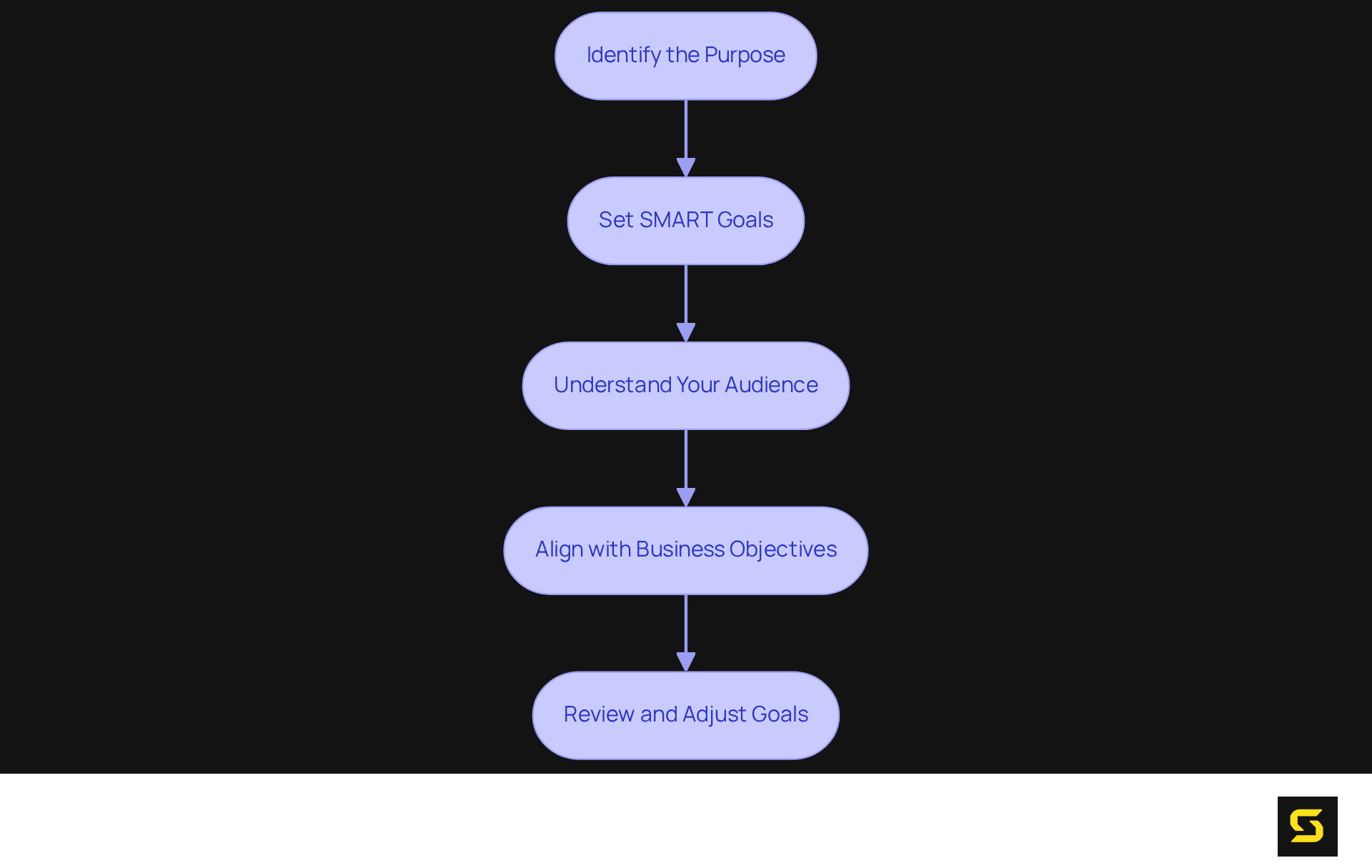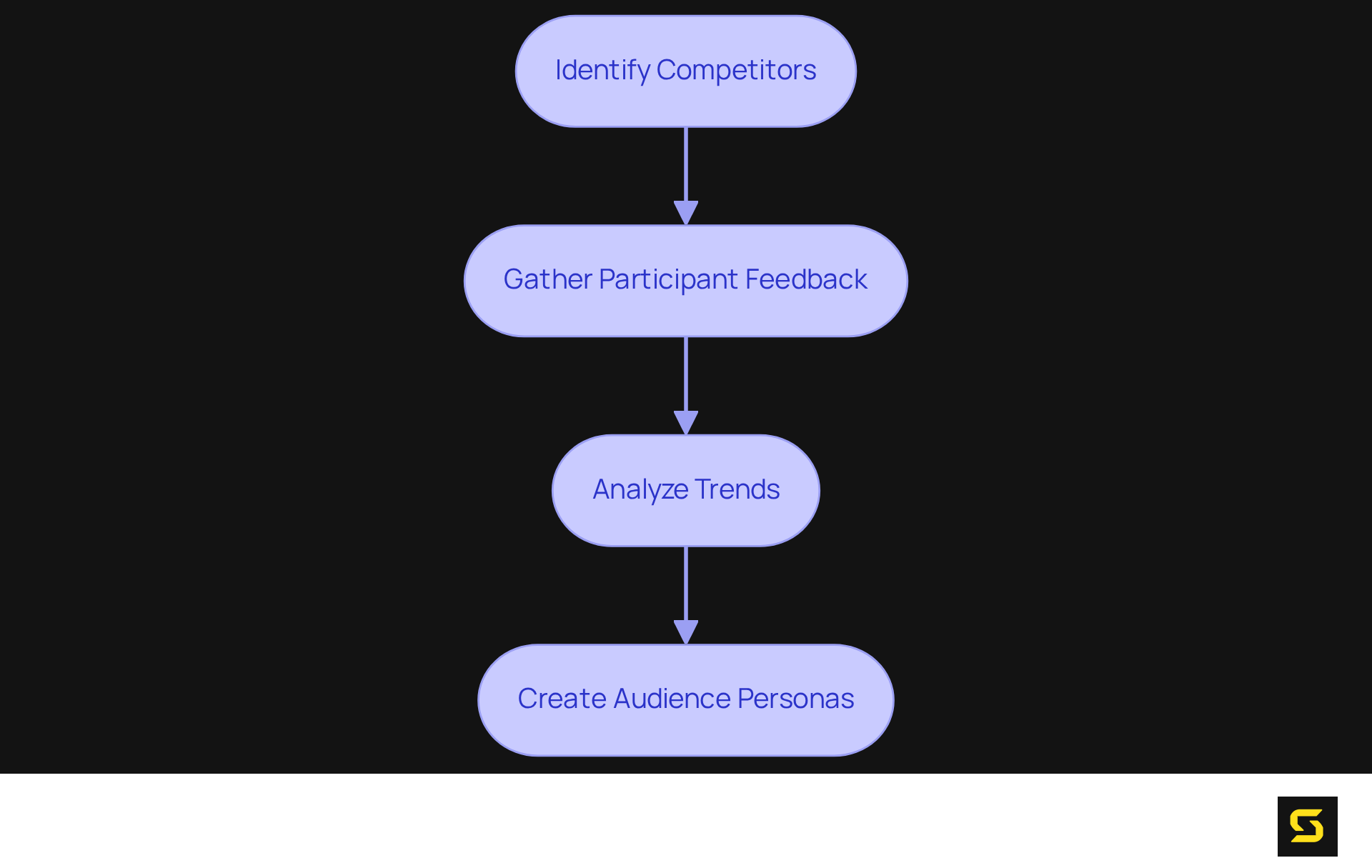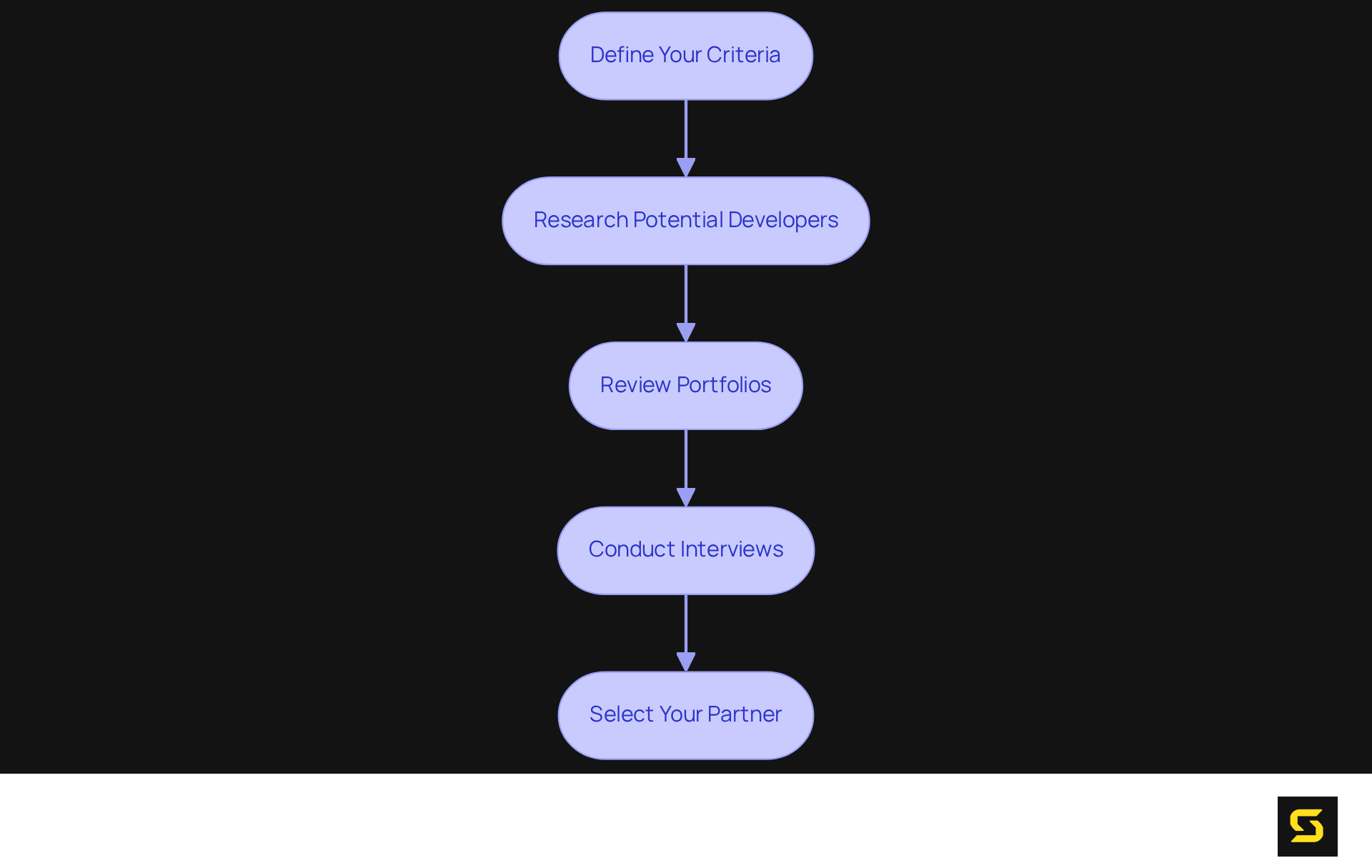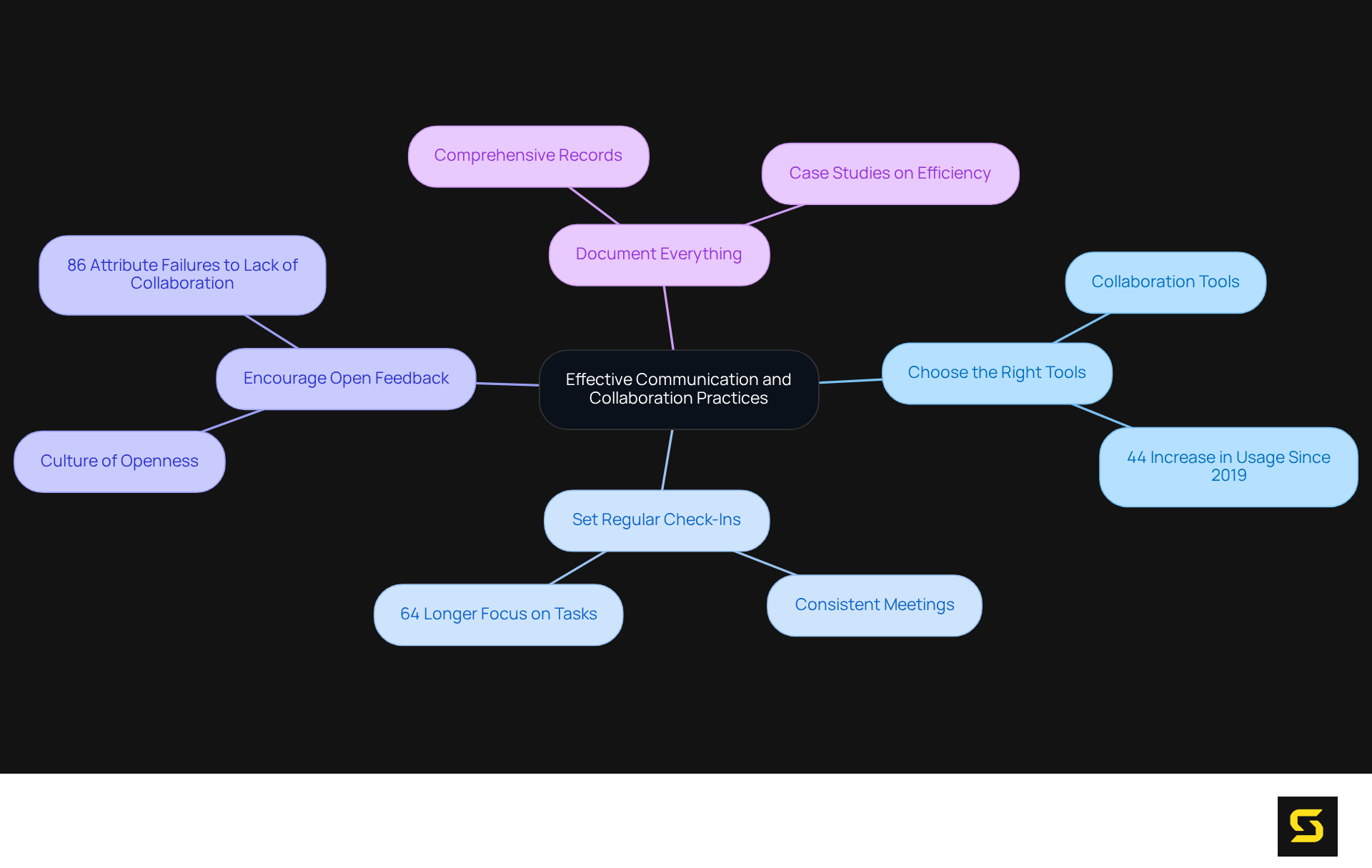Overview
The article presents a systematic approach to identifying the right app developers in your vicinity. It underscores the necessity of:
- Defining development goals
- Conducting thorough market research
- Evaluating potential developers
- Establishing effective communication practices
Each of these steps is bolstered by practical strategies and research findings that emphasize the significance of:
- Clear objectives
- An understanding of user needs
- The cultivation of collaboration
This comprehensive methodology is essential for ensuring successful outcomes in app development.
Introduction
Finding the right app developers can indeed be a daunting task, particularly in a landscape teeming with options and diverse expertise. The journey to creating a successful app commences with a clear understanding of development goals and a meticulous evaluation of potential partners.
However, many entrepreneurs find themselves struggling to navigate this process effectively, often resulting in misaligned expectations and costly mistakes.
So, how can one ensure they select the best app developers—those who not only grasp their vision but can also bring it to fruition?
This guide delineates four essential steps to streamline the search for app developers nearby, ensuring that the right collaboration paves the way for app success.
Define Your App Development Goals
To begin, clearly outline the objectives of your app. Consider the following steps:
- Identify the Purpose: Determine the primary function of your app. Will it solve a specific problem, enhance engagement, or provide a valuable service?
- Set SMART Goals: Ensure your goals are Specific, Measurable, Achievable, Relevant, and Time-bound. For instance, instead of stating 'boost engagement,' specify 'raise daily active participants by 20% within six months.' Research indicates that setting challenging yet attainable goals can lead to up to 90% better performance when they are clearly defined and regularly reviewed.
- Understand Your Audience: Identify your target audience and their needs. This understanding will guide your app's features and design. Engaging with potential users early on can validate your concept and ensure its relevance.
- Align with Business Objectives: Confirm that your app goals support your overall business strategy. For example, if your business aims to expand into new areas, your app should cater to those demographics. Regularly reviewing and adjusting your goals is crucial; companies that do so are 31% more likely to achieve their objectives than those that do not.

Conduct Market Research
Conducting thorough market research is essential and involves several key steps:
-
Identify Competitors: Begin by researching existing apps that serve a similar purpose. Examine their strengths and weaknesses to uncover gaps in the industry. Understanding the competitive landscape is crucial; it not only helps define your unique value proposition but also identifies potential barriers to entry. Furthermore, consider indirect or secondary competitors that may influence your market position.
-
Gather Participant Feedback: Engage directly with potential users through surveys, interviews, or focus groups to collect insights about their preferences and pain points. Statistics reveal that direct participant engagement methods yield nuanced insights, which are vital for refining app features and enhancing user satisfaction.
-
Analyze Trends: Stay informed about industry trends and technological advancements that could impact your app's success. Tools like Google Trends provide valuable information on interests and emerging technologies, enabling you to adjust your strategy accordingly. For instance, the mobile application sector is projected to generate over $935 billion in revenue by 2024, highlighting the importance of remaining ahead of industry changes. AI-native app design will be central to future applications, allowing them to adapt and deliver hyper-personalized experiences.
-
Create Audience Personas: Develop detailed profiles of your target audience based on your research. This approach will help tailor your app's features to meet their specific needs. By understanding the demographics and behaviors of your audience, you can enhance user engagement and retention, which are crucial for long-term success in the app industry. The U.S. Small Business Administration (SBA) offers valuable resources for effective research methods, further guiding your market analysis.

Evaluate and Shortlist App Developers
To effectively evaluate and shortlist app developers, it is essential to follow a structured approach:
-
Define Your Criteria: Begin by clearly outlining the necessary skills and experience for your project. Key factors to consider include technical expertise, industry experience, and the quality of their portfolio. Successful startups underscore the importance of organized criteria to ensure alignment with their objectives. As Joshua Davidson, Founder & CEO of Chop Dawg, states, "We believe in being more than just coders; we strive to be mentors, product strategists, and cheerleaders for your vision."
-
Research Potential Developers: Utilize platforms such as Upwork, LinkedIn, or local directories to identify potential developers. Pay close attention to reviews and ratings from previous clients, as these insights can reveal their reliability and performance. Notably, startups like Slack and WhatsApp have thrived by thoroughly researching their development partners. Given that a basic app can cost between $10,000 to $50,000, it is crucial to select the right partner.
-
Review Portfolios: Assess the portfolios of potential developers to evaluate their previous work. Seek projects that reflect your own in complexity and functionality. Metrics such as user ratings and success rates can indicate how well developers have performed in comparable endeavors, assisting you in making informed decisions.
-
Conduct Interviews: Prepare a comprehensive list of questions to assess their technical skills, problem-solving capabilities, and communication style. This step is vital for understanding their approach to development and collaboration. Engaging in meaningful discussions can clarify how well they align with your vision and requirements.
By adhering to these steps, you can ensure a thorough evaluation process that culminates in selecting the right app development partner for your project.

Establish Communication and Collaboration Practices
To establish effective communication and collaboration practices, consider implementing the following strategies:
-
Choose the Right Tools: Leverage collaboration tools such as Slack, Trello, or Asana to enhance communication and streamline task management. Ensuring proficiency among all team members with these tools can significantly boost workflow efficiency. Notably, a study reveals that teams utilizing online collaboration tools have experienced a 44% increase in their usage since 2019, underscoring their growing importance in enhancing productivity.
-
Set Regular Check-Ins: Establish a schedule for consistent meetings to review progress, address challenges, and adapt plans as necessary. Research indicates that teams with regular check-ins achieve higher project success rates, as these meetings foster alignment and accountability. In fact, employees who embrace collaborative working focus on tasks 64% longer than their solo counterparts, emphasizing the benefits of regular engagement.
-
Encourage Open Feedback: Cultivate a culture where team members feel empowered to share their insights and concerns. This openness can lead to innovative solutions and continuous improvement. A survey found that 86% of respondents attribute workplace failures to a lack of collaboration, highlighting the critical need to foster a collaborative environment.
-
Document Everything: Maintain comprehensive records of decisions, changes, and feedback throughout the development process. This documentation not only serves as a valuable reference but also enhances clarity and minimizes misunderstandings among team members. Case studies, such as the one conducted on Runn, illustrate that effective documentation and the strategic use of collaboration tools can significantly enhance team efficiency and employee well-being.
By implementing these practices, app developers near me can foster a collaborative environment that enhances productivity and innovation.

Conclusion
Finding the right app developers is not just a step; it is a crucial milestone for any business aiming to create a successful application. By clearly defining app development goals, conducting thorough market research, evaluating potential developers, and establishing effective communication practices, businesses position themselves for success. Each of these steps is vital in ensuring that the final product aligns seamlessly with both user needs and business objectives.
This article outlines essential strategies, beginning with a clear understanding of the app's purpose and target audience. It emphasizes the necessity of conducting market research to identify competitors and gather user feedback, significantly enhancing the app's features and overall appeal. Furthermore, the process of evaluating and shortlisting developers is underscored, highlighting the importance of defining criteria, reviewing portfolios, and conducting interviews to find the right fit. Finally, fostering a collaborative environment through effective communication and the use of collaboration tools is stressed, as it leads to improved productivity and innovative solutions.
In conclusion, the journey to finding the right app developers transcends mere technical skills; it encompasses strategic alignment and effective collaboration. By adhering to these outlined steps, businesses ensure they are not only choosing the right partners but also establishing a solid foundation for a successful app that meets market demands. Embracing these practices will not only enhance the app development process but also contribute to long-term success in a competitive landscape.
Frequently Asked Questions
What are the first steps to define app development goals?
The first steps include identifying the purpose of the app, setting SMART goals, understanding your audience, and aligning with business objectives.
How can I identify the purpose of my app?
Determine the primary function of your app by asking whether it will solve a specific problem, enhance engagement, or provide a valuable service.
What does SMART stand for in goal setting?
SMART stands for Specific, Measurable, Achievable, Relevant, and Time-bound.
Can you give an example of a SMART goal for app development?
Instead of saying "boost engagement," a SMART goal could be "raise daily active participants by 20% within six months."
Why is it important to understand your audience when developing an app?
Understanding your target audience and their needs will guide your app's features and design, helping to validate your concept and ensure its relevance.
How should app goals align with business objectives?
App goals should support your overall business strategy; for example, if your business aims to expand into new areas, the app should cater to those demographics.
What is the benefit of regularly reviewing and adjusting app goals?
Regularly reviewing and adjusting goals is crucial, as companies that do so are 31% more likely to achieve their objectives than those that do not.





